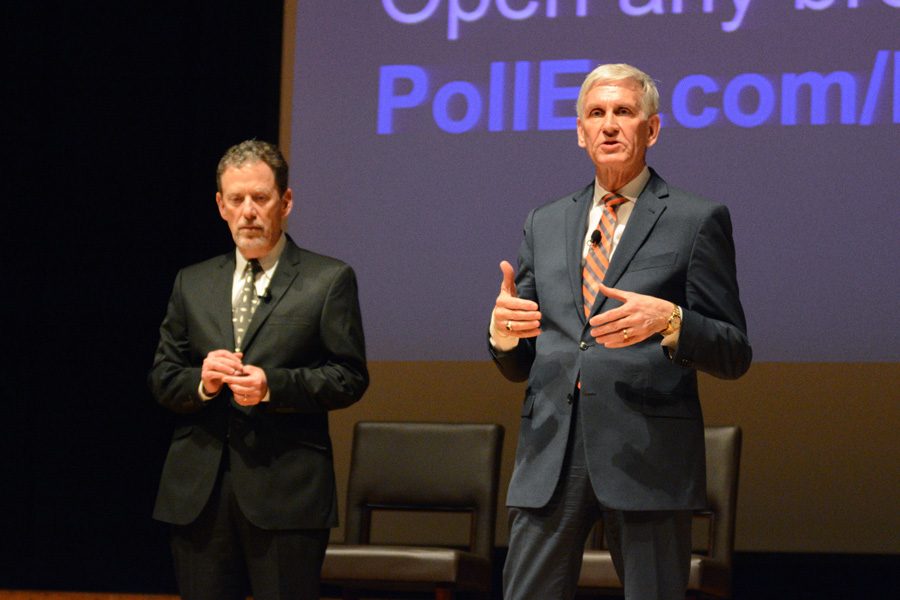Education officials struggle with current funding proposals
Daily file photo by Lauren Duquette
School District 202, along with Evanston/Skokie School District 65, could lose millions of dollars under a new state Senate bill that would reallocate funds. The bill passed the Senate last Tuesday, and it is currently being reviewed in the Illinois House.
May 15, 2016
Although Evanston education officials said they do not agree with Gov. Bruce Rauner’s proposal to fund education using the current model, they do not believe new Illinois Senate legislation to reallocate funding across districts addresses the needs of students in mixed-income areas.
The Senate bill, a proposal to reallocate funds to districts that need the money the most, could be a step in the right direction, they said. However, if the legislation passes, School District 202 and Evanston/Skokie School District 65 would lose approximately $2.2 million and $6.2 million respectively, which is virtually all of their state funding, officials said.
With the current model, districts rely primarily on taxpayer money to fund their schools as a result of low state funding.
“It ends up being a bill that takes money away from school districts like Evanston’s to support other school districts,” said Gretchen Livingston, a District 202 board member. “It’s not equitable to take money away from a district like ours where over 40 percent of our students are eligible for free and reduced lunch.”
The bill is an effort to take resources from specifically high tax wealth districts, such as those in Evanston, and redistribute those resources, District 65 superintendent Paul Goren said.
“The vast majority of our school funding is supplied by property taxes from the citizens of Evanston,” Livingston said. “Not every district taxes their citizens to the maximum that they’re allowed by law. We do, and our citizens support it.”
Although Evanston’s districts have high tax wealth, they also serve a wide diversity of students, more than 42 percent of whom live at or below the poverty line, Goren said. He added the bill does not address the “nuances” in these students’ needs.
Livingston acknowledged that the bill has gained support from some Evanston representatives, such as state Sen. Heather Steans (D-Chicago), who represents the southwest corner of the city as well as parts of Chicago. This is largely due to the fact that the biggest beneficiary of the bill is Chicago Public Schools, Livingston added.
On the other hand, Rauner is backing a proposal to fund education at 100 percent compared to the 92 percent of this past year, Goren said. He said through the governor’s proposal, Evanston districts would gain money, with District 65 receiving $160,000 more than it currently receives from the state.
However, Rauner’s proposal does not address the fact that the current model needs reform, said Brian Battle, vice chair of Ed-Red, a lobbying organization that includes school districts in suburban Cook County. Battle said Rauner mentioned he was willing to look at changes to the present formula in future years, but he did not specify what those changes would be.
Both Goren and Livingston said although they couldn’t determine the exact impact of losing millions of dollars, more than 80 percent of their districts’ costs are personnel costs, meaning there would be reductions in staff.
The bill passed the Senate last Tuesday and is currently being reviewed in the House. Also on Tuesday, Ed-Red executives presented their own proposal to the House Education Task Force, a proposal backed by District 202 board members, Livingston said.
Battle, who testified for the General Assembly, said the proposal was developed by several Illinois education stakeholders, including Ed-Red. He said he presented an evidence-based adequacy model as an alternative to the current model. This model establishes district-specific costs based on each district’s student success outcomes, Battle said.
“It starts out right with the core education costs,” he said. “Then we apply additional resources for students that are considered at-risk like low-income kids, English learners, special education students. And we think that the funding target to come out of that adequacy model is a more accurate reflection of what today’s funding needs within Illinois are.”
Battle said the proposal he presented and the Senate bill are similar in many ways because they both aim to improve the distribution of resources across the state. However, Battle said Ed-Red’s proposal not only does a better job of identifying the districts in need on an objective basis, but also will not take existing funds from school districts.
“While we allocate for additional funds, we also say that no district should receive less than what they got last year,” Battle said. “Everyone is really hopeful that within the next year or two there will be a legislative solution that will improve (the current model) along with hopefully additional investment in education.”
Livingston said school board members have attempted to “get the word out” to Evanston residents, but it is difficult to mobilize advocacy around the issue.
“This is all part of the great unknown coming out of our state capital,” Goren said. “In general, the community knows that there’s great uncertainty in Springfield, knows that the resources are not going to be available for future, but hasn’t quite yet felt the ramifications of any actions because nothing has been done. Nothing has been done in Springfield for over a year.”
Email: rishikadugyala2019@u.northwestern.edu
Twitter: @rdugyala822



